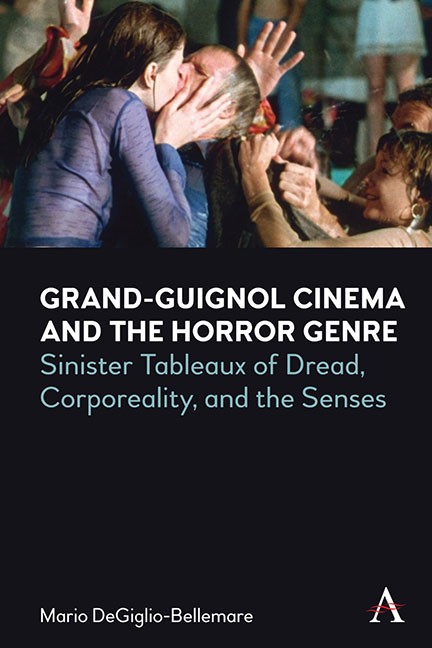Book contents
- Frontmatter
- Dedication
- Contents
- Miscellaneous Frontmatter
- Introduction: Grand-Guignol Cinema and the Senses: Eyes Without a Face, Attractions, Affect and Facial Trauma
- Chapter One The Grand-Guignol Theatre: A Short History of theTheatre and Spatial Ecologies of Dread The Hitch-Hiker and Shivers
- Chapter Two Grotesque Carnivals of “Stubborn” Aurality: Embodied Discourse in Early Talkie Horror Cinema Murders in the Rue Morgue, Freaks, and The Black Cat
- Chapter Three The Sight of Corpses in the Ruins of Modernity: Surgical Sadists under Censorship: The Body Snatcher, and Mad Love, The Blood of the Beasts
- Chapter Four Erotic Abattoirs of Bad Taste: Unproductive Potlatch in Exploitation Cinema: Fascination, Grapes of Death, and Salò, or 120 Days of Sodom
- Chapter Five French Colonial Skinning: Affect and Becoming-Wound in the Cinema of Sensation: Trouble Every Day, Sombre, and In My Skin
- Conclusion: Drag Performativity and Multisensorial Dread Blood and Black Lace and Psycho
- Bibliography
- Index
Chapter Two - Grotesque Carnivals of “Stubborn” Aurality: Embodied Discourse in Early Talkie Horror Cinema Murders in the Rue Morgue, Freaks, and The Black Cat
Published online by Cambridge University Press: 15 November 2023
- Frontmatter
- Dedication
- Contents
- Miscellaneous Frontmatter
- Introduction: Grand-Guignol Cinema and the Senses: Eyes Without a Face, Attractions, Affect and Facial Trauma
- Chapter One The Grand-Guignol Theatre: A Short History of theTheatre and Spatial Ecologies of Dread The Hitch-Hiker and Shivers
- Chapter Two Grotesque Carnivals of “Stubborn” Aurality: Embodied Discourse in Early Talkie Horror Cinema Murders in the Rue Morgue, Freaks, and The Black Cat
- Chapter Three The Sight of Corpses in the Ruins of Modernity: Surgical Sadists under Censorship: The Body Snatcher, and Mad Love, The Blood of the Beasts
- Chapter Four Erotic Abattoirs of Bad Taste: Unproductive Potlatch in Exploitation Cinema: Fascination, Grapes of Death, and Salò, or 120 Days of Sodom
- Chapter Five French Colonial Skinning: Affect and Becoming-Wound in the Cinema of Sensation: Trouble Every Day, Sombre, and In My Skin
- Conclusion: Drag Performativity and Multisensorial Dread Blood and Black Lace and Psycho
- Bibliography
- Index
Summary
In this chapter, I will focus predominantly on the dreadful aurality and carnivalesque approach in Robert Florey’s Murders in the Rue Morgue (1932), a film that is exemplary of the Grand-Guignolesque in the early talkie period. My focus is to discuss the place of the uncanny voice, especially the “stubborn” scream, in 1930s cinema as part of a genealogical intervention into Grand-Guignol cinema. The Grand-Guignol theatre was a place that staged its plays without music (excluding the diegetic) or an orchestra pit, and where the spoken word was instead central. As an arena of embodied knowing and corporeal speech acts, the carnival environment of Florey’s film suggests something of the heterogeneity taken up within Grand-Guignol cinema. Loosely based on Edgar Allan Poe’s iconic detective story of the same title (1841), Florey’s Murders in the Rue Morgue opens with scenes of carnival attractions, as the grotesque body of “Erik the ape” is put on display by Bela Lugosi’s Dr. Mirakle. The audience reception of the grotesque body of Erik the ape at the carnival resonates affectively with the circulating “stub-born” scream of first-time actress Arlene Francis, who plays an anonymous sex worker in the film who is later abducted and killed. Grotesque aurality serves as a springboard for considering the lowly, the bawdy and the corporeally excessive. Considerations of early sound films in the horror genre have overlooked the stubborn screams of Francis to focus instead on the spectacle of films like King Kong (Merian C. Cooper and Ernest B. Schoedsack, 1933). Released the year after the Rue Morgue, Kong gave the genre its first recognisable “scream queen” in Fay Wray’s Ann Darrow. But just as the racialised grotesque body of Murders in the Rue Morgue’s Erik the ape prefigures the spectacular body of Kong, so too does Francis’s scream prefigure Wray’s. This study of Grand-Guignol maps such anxieties through the materiality of the scream in early 1930s horror cinema, which produced affective intensities across the bodies of viewers.
According to Mikhail Bakhtin, the carnivalesque is categorised by a celebration of the grotesque and excessive body, especially the open orifices and protrusions of the “lower stratum” (1984: 325). Agnès Pierron argues that the carnivalesque is one of the major themes of the Grand-Guignol in which symbolic inversions take centre stage (1995: XIX).
- Type
- Chapter
- Information
- Grand-Guignol Cinema and the Horror GenreSinister Tableaux of Dread, Corporeality and the Senses, pp. 63 - 96Publisher: Anthem PressPrint publication year: 2023



